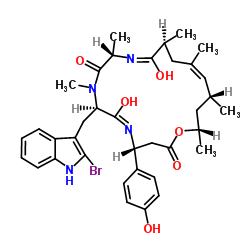Actin dynamics rapidly reset chemoattractant receptor sensitivity following adaptation in neutrophils.
Sheel N Dandekar, Jason S Park, Grace E Peng, James J Onuffer, Wendell A Lim, Orion D Weiner
文献索引:Philos. Trans. R. Soc. Lond., B, Biol. Sci. 368(1629) , 20130008, (2013)
全文:HTML全文
摘要
Neutrophils are cells of the innate immune system that hunt and kill pathogens using directed migration. This process, known as chemotaxis, requires the regulation of actin polymerization downstream of chemoattractant receptors. Reciprocal interactions between actin and intracellular signals are thought to underlie many of the sophisticated signal processing capabilities of the chemotactic cascade including adaptation, amplification and long-range inhibition. However, with existing tools, it has been difficult to discern actin's role in these processes. Most studies investigating the role of the actin cytoskeleton have primarily relied on actin-depolymerizing agents, which not only block new actin polymerization but also destroy the existing cytoskeleton. We recently developed a combination of pharmacological inhibitors that stabilizes the existing actin cytoskeleton by inhibiting actin polymerization, depolymerization and myosin-based rearrangements; we refer to these processes collectively as actin dynamics. Here, we investigated how actin dynamics influence multiple signalling responses (PI3K lipid products, calcium and Pak phosphorylation) following acute agonist addition or during desensitization. We find that stabilized actin polymer extends the period of receptor desensitization following agonist binding and that actin dynamics rapidly reset receptors from this desensitized state. Spatial differences in actin dynamics may underlie front/back differences in agonist sensitivity in neutrophils.
相关化合物
| 结构式 | 名称/CAS号 | 分子式 | 全部文献 |
|---|---|---|---|
 |
Jasplakinolide
CAS:102396-24-7 |
C36H45BrN4O6 |
|
Rapid changes in phospho-MAP/tau epitopes during neuronal st...
2011-01-01 [PLoS ONE 6 , e20878, (2011)] |
|
P2Y2 receptor signaling in neutrophils is regulated from ins...
2015-08-15 [Exp. Cell Res. 336 , 242-52, (2015)] |
|
Actin polymerization controls the activation of multidrug ef...
2012-09-01 [Mol. Biol. Cell 23(18) , 3663-72, (2012)] |
|
F-actin-myosin II inhibitors affect chromaffin granule plasm...
2012-10-01 [J. Mol. Neurosci. 48(2) , 328-38, (2012)] |
|
Endothelial actin depolymerization mediates NADPH oxidase-su...
2014-01-01 [Am. J. Physiol. Heart Circ. Physiol. 306(1) , H69-77, (2014)] |